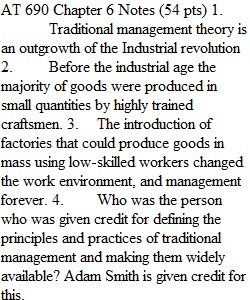


Q AT 690 Chapter 6 Notes (54 pts) 1. Traditional management theory is an outgrowth of the _______________________ revolution 2. Before the industrial age the majority of goods were produced in small quantities by highly trained _________________________. 3. The introduction of factories that could produce goods in _____________ using ________-______________ workers changed the work environment, and management forever. 4. Who was the person who was given credit for defining the principles and practices of traditional management and making them widely available? 5. Traditional management creates distinct divisions between the roles and responsibilities of _____________ and ________________________. 6. Under this theory managers do not consider employee _______________ or __________________. 7. Under this theory management does not feel that employees are capable of making sound decisions and assumes they will develop into____________________ bodies under the careful guidance of a ______________ manager. 8. An example of where traditional management was used is where? 9. When employees perform small, ____________________task out of thousands required to produce a car, few felt much _____________________ for the overall quality of the finished product. 10. Under traditional management in the automotive factory managers were assigned the responsibility for judging the _____________________ of the finished product 11. Traditional managers think they are responsible for everything and take all the ______________ when things go well. 12. With traditional management supervisors are concerned about __________________ and _____________________. 13. The managers are worried they will lose their _________________ if things do not go well. 14. The traditional managers are proud of their _______________________ and if things fail they will feel that it is the fault of the _______________________. 15. What are the three major fears of supervisors under traditional managers that reduces their efficiency? (3pts) 16. Traditional managers are reluctant to ___________________ responsibility. 17. These managers realize that failure to meet objectives may be seen as their inability to _____________. 18. They try to reduce the risk or failure by applying tighter controls and _______________________ every action. 19. What is the main concern for a manager that does not give up some power and delegate responsibility? 20. Hopefully the manager has a unique combination of training, intellectual capacity, and previous experience make him or her best _____________________ to direct a group of employees. 21. In most situations employees have and unique perspective on _______________________, _______________________ and ________________________. 22. Getting input from employees provides fresh ________________________ and differing ____________________. 23. Asking for input from employees allows them to feel more ________________________ and are more likely to feel more involved and motivated to help achieve organizational_____________________. 24. What may happen if you involve employees in decisions? 25. Having employees showing the potential to become better managers than their supervisors should not be seen as a ______________________ but a _______________. 26. An innovative and strong manager begins his or her work by looking to identify and train his or her _________________________. 27. What is the result of a manager who engages and inspires workers to reach new heights and as a result productivity of the entire operation is maximized. 28. In the automotive industry the best producer of the shop is usually elevated to the position of the ____________________. 29. The goal of the business is ___________________, satisfied customers, and most important __________________________. 30. The theory of scientific management was developed by _________________ _________________. 31. Taylor was passionate about finding new and better ways to improve ___________________ and _______________________ in manufacturing. 32. Taylor has been acknowledged as the “father of ___________________ management”. 33. Scientific managements goal was consistency and efficiency and to bring greater prosperity for both the ________________________ and _______________________. 34. What are three workplace concerns that Taylor felt were at the root of efficiency. (3pts) 35. Employees under traditional management felt that they could be easily ____________________ or ____________________ which lead to serious morale problems. 36. Taylor predicted that increased productivity would result in increased ______________________. 37. Another obstacle that scientific management worked to resolve was the natural tendency of all workers to work at a _____________________ pace which was known as _______________________. 38. What eventually happens if slower workers get paid the same as faster workers? 39. Taylor believed that management asked employees to do too _______________ and that employees did not have _____________________ or___________________ to do their jobs completely or consistently. 40. He felt that the quality and consistency could never be maximized so he developed a process of doing ________________ and __________________ studies. 41. Time and motion studies determine the best way to perform a task with the minimum of wasted _____________ and _______________. 42. Taylor’s organizational concept envisions the workplace like a large ________________________. 43. Taylor’s method made a major contribution to the achievement of consistent ___________________ and ___________________________. 44. Taylor’s theory markedly improved efficiency but failed to improve on the low employee __________________ that was carried over from traditional management. It actually increased it. 45. Management by objective (MBO) is centered around the philosophy that management and employees had to work together to clearly define and agree upon _____________ and_____________________. 46. MBO not only aims to set goals but also requires defining a __________________ for achieving them. 47. According to the MBO theory everyone within the organization must commit to focus on four items. What are they? (4pts)
View Related Questions